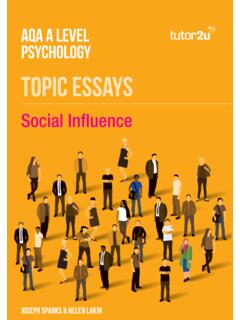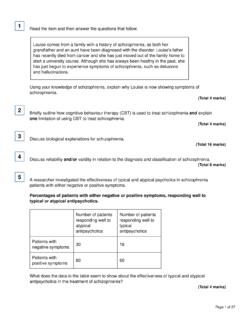Transcription of Forensic Psychology
1 1 Unit 3 Forensic Psychology Offender profiling: o The top-down approach, including organised and disorganised types of offender o The bottom-up approach including investigative Psychology ; geographical profiling. Biological explanations of offending behaviour: o An historical approach (atavistic form) o Genetics and neural explanations. Psychological explanations of offending behaviour: o Eysenck s theory of the criminal personality o Cognitive explanations - level of moral reasoning and cognitive distortions, including hostile attribution bias and minimalisation. o Differential association theory o Psychodynamic explanations.
2 Dealing with offending behaviour: o The aims of custodial sentencing and the psychological effects of custodial sentencing o Recidivism o Behaviour modification in custody o Anger management o Restorative justice programmes. 2 Offender profiling Offender profiling is based on the idea that the characteristics of an offender can be deduced from the characteristics of the offence and the particulars of the crime scene. The main aim of offender profiling is to narrow the field of enquiry and the list of likely suspects. Methods vary, but the compiling of a profile will usually involve careful scrutiny of the crime scene and analysis of the evidence (including witness reports) in order to generate hypotheses about the probable characteristics of the offender (their age, background, occupation, etc) There are two main types of offender profiling: Top-down approach and Bottom-up approach.
3 Top-down approach (also known as Top-down typology) The top-down approach to offender profiling originated in the United States as a result of work carried out by the FBI in the 1970 s. More specifically, the FBI s Behavioural Science Unit drew upon data gathered from in-depth interviews with 36 sexually motivated serial killers including Ted Bundy and Charles Manson. Profilers who use this method will match what is known about the crime and the offender to a pre-existing template that the FBI developed using the data they gathered from the interviews they conducted. Murderers or rapists are classified in one of two categories (organised or disorganised) on the basis of the evidence, and this classification informs the subsequent police investigation.
4 Organised and disorganised types of offender The distinction between organised and disorganised offenders is based on the idea that serious offenders have a particular way of 'working' (this is referred to as modus operandi MO) and that these generally correlate with a particular set of social and psychological characteristics that relate to the individual. See table on the next page. 3 Organised offenders Disorganised offenders Shows evidence of having planned the crime in advance The victim is deliberately targeted and will often reflect the fact that the killer or rapist has a 'type'. They maintain a high level of control during the crime and may operate with almost detached surgical precision.
5 There is little evidence or clues left behind at the scene. They tend to be of above-average intelligence, in a skilled, professional occupation and are socially and sexually competent. They are usually married and may even have children. Shows little evidence of planning suggesting the offence may have been a spontaneous, spur of the moment act. The crime scene tends to reflect the impulsive nature of the attack the body is usually still at the scene and there appears to have been very little control on the part of the offender. They tend to have a lower than average IQ, be in unskilled work or unemployed, and often have a history of sexual dysfunction and failed relationships.
6 They tend to live alone and often relatively close to where the offence took place. Constructing a profile: There are four main stages in the construction of an FBI profile: 4 Evaluation of the Top-down approach Only applies to certain crimes This method of profiling can only really be used in crimes of murder and rape. More common offences such as burglary do not lend themselves to profiling because the resulting crime reveals very little about the offender. This restricts the applicability of the top-down approach, unlike geographic profiling (part of the bottom-up approach) which looks at the pattern of crime rather than the crime type, making it more versatile.
7 This means that it can be argued to be a limited approach to identifying a criminal. Too simplistic Having two categories of a criminal is very simplistic. It is likely that criminals do not fit neatly into either category, therefore making the prediction of their characteristics difficult. It is likely there will be more types, and the distinction is too restrictive. This ultimately affects the accuracy of the profiling system. Evaluation extra The behaviours that describe each of the organised and disorganised types are not mutually exclusive, a variety of combinations could occur in any given murder scene.
8 This has prompted other researchers to propose more detailed typological models Holmes (1989) suggests there are four types of serial killer: visionary, mission, hedonistic and power/control whereas Robert Keppel and Richard Walter (1999) focus more on the different motivations killers might have rather than trying to determine specific 'types'. Original sample The Top-down approach was developed using interviews with 36 sexually motivated murderers in the US. It could be argued that the sample is too small and unrepresentative to base the typology system to. Also, this classification system was constructed based on self-report data from convicted killers meaning there could be issues with the validity of the data gathered from the interviews.
9 Lack of theoretical foundation The Top-down approach could be seen as a more intuitive approach to offender profiling, it often relies on the expertise of the profiler which is problematic as this raises issues of subjectivity. There is also a lack of background evidence to suggest why it works. Therefore, this method of profiling could be criticised in terms of its credibility as it can be considered less scientific than the Bottom-up approach. 5 Bottom-up approach The aim of the Bottom-up approach is to generate a picture of the offender ( likely characteristics, routine behaviour and social background) through systematic analysis of evidence at the crime scene.
10 Unlike the American Top-down approach, the British model does not begin with fixed typologies. Instead, the profile is 'data driven' and emerges as the investigator engages in deeper and more rigorous scrutiny of the details of the offence. Bottom-up profiling is also much more grounded in psychological theory than the Top-down approach. It makes use of smallest space analysis which is a computer program that identifies correlations across patterns of behaviour. A key psychologist in the Bottom-up approach is David Canter. Investigative Psychology Investigative Psychology attempts to apply statistical procedures, alongside psychological theory, to the analysis of crime scene evidence.









